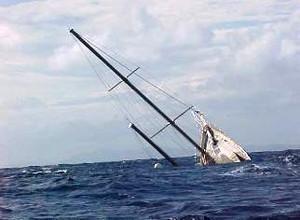Self Healing Yacht Hulls- One Student's Research
by IEEE Spectrum on 18 Nov 2008

If only we’d had one of those self-healing hulls! SW
'We were sailing at night when we hit the whale. We were thrown from our bunks by the collision, which shocked us all, and knocked a large split in the side of the yacht. However, with our self healing hull, only a small amount of water entered before the hole covered again, and the automatic pumps were able to deal with it easily...'
Sounds like stuff from a science fiction movie? In the future, it just may be possible, thanks to a female doctoral student in Lausanne, Switzerland.
Among the claims to fame of Switzerland’s Ecole Polytechnique Fédérale de Lausanne (EPFL) is Alinghi, the yacht, which won not one but two America’s Cups. Part of that success can be attributed to the state-of-the-art carbon-fiber composites that make up Alinghi’s hull. In many cases, such composites can substantially heal themselves following a collision. Now a graduate student has invented a way to juice the self-healing with a little electric current.
EPFL doctoral student Eva Kirkby is developing a better way for carbon-composite materials to heal themselves. Carbon-fiber composites, made from many layers of lightweight carbon fibers and epoxy, offer a strength-to-weight ratio much higher than that of similar-weight materials. They’re often found in Formula One race cars, and they make up 50 percent of the Boeing 787 airliner. But one weakness of these superstrong materials is a tendency to separate internally, or delaminate, when big impacts cause cracks parallel to the surface of the material. Delamination damage can decrease the composite’s strength by an order of magnitude.
To counter this, a self-healing composite material is impregnated with hundreds of tiny, evenly dispersed bubbles filled with healing liquid-monomer molecules (about 10 bubbles per cubic centimeter) and smaller particles of catalyst that harden the monomer. When the material sustains a sufficient impact, the delamination cracks cause some bubbles to rupture and release their monomer and catalyst. The monomer fills the crack and hardens, and the damage is repaired. The problem with this approach is that for maximum material strength, you want to keep the concentration of bubbles and their size to a minimum. But when the bubbles are too small, their payload doesn’t completely fill the cracks.
So Kirkby found a way to close the gap. She incorporated wires of what’s known as a shape-memory alloy, or SMA, into the composite. When electricity flows through an SMA wire that has been bent, it snaps back into shape. That forces the delamination crack shut, constraining it to a size that can be effectively filled by fewer, tinier monomer bubbles. In initial tests, Kirkby’s electrically activated material performed beautifully. The crack openings were reduced from 120 micrometers to about 17 µm.
Kirkby says that among the key issues is how to get this material to autonomously pulse the current to the SMA wires. To do that, the composite must first figure out where it has been damaged and then send current only to the SMA wires at the damage site.
Kirkby embedded optical fibers in the composite. When a shock pulse from an impact compressed or tensed the fibers, the light that passed through them dimmed or intensified in response. By tracking the pulse as it transected the fibers, Kirkby was able to pinpoint the impact site to within a few centimeters.
'What’s interesting about this is that it merges the two different directions structural composite work has been going,' says Iowa State University assistant professor Michael Kessler, who coauthored a seminal 2001 paper on self-healing composites. 'I like the idea of combining a healing and a sensing function.' But he cautions that a lot more work is required to create the damage-sensing logic devices that would make self-healing materials autonomous.
Kirkby says one obvious application for her new material is high-performance sports equipment like racing bikes and, of course, yachts, including Allinghi. The aerospace sector would benefit from autonomously healing aircraft wings or meteor-proof satellites, and for injured soldiers returning to duty wearing prosthetics, self-repair could be essential.
If you want to link to this article then please use this URL: www.sail-world.com/50903

